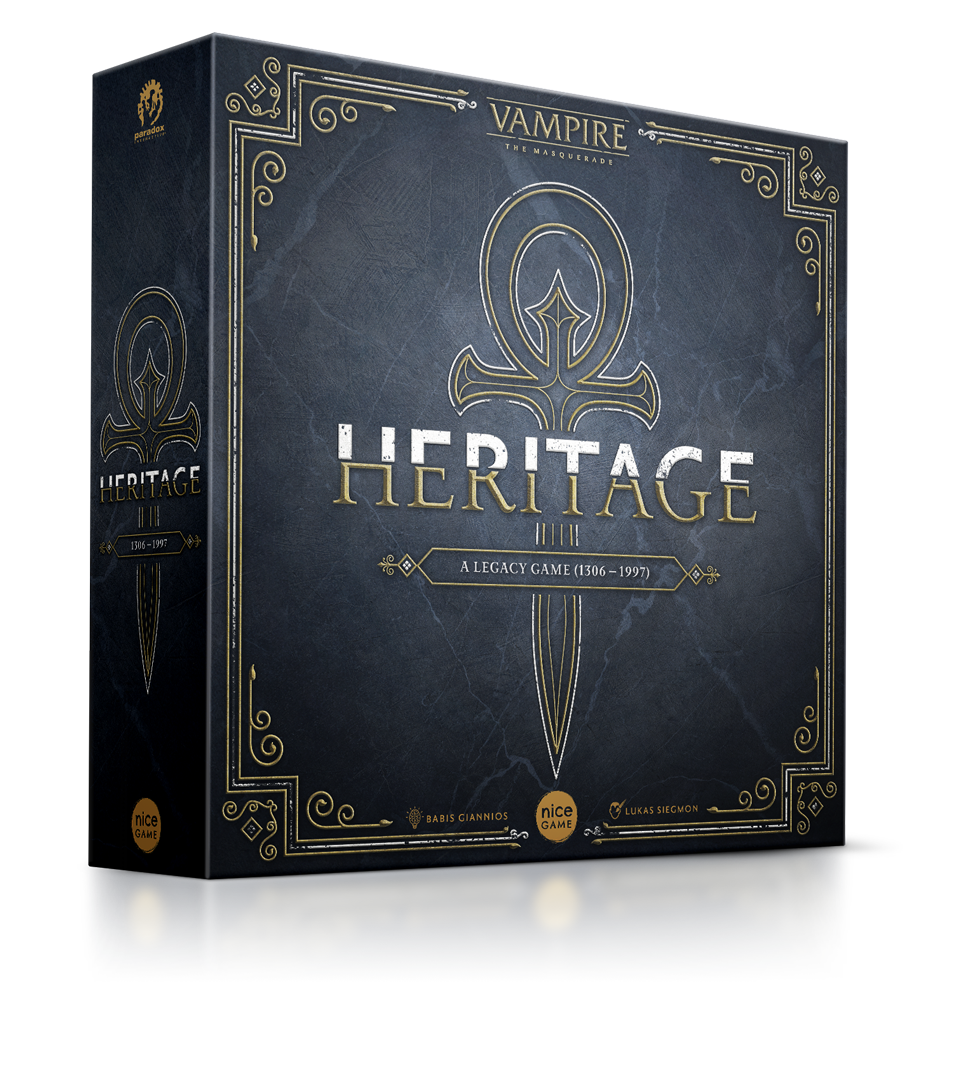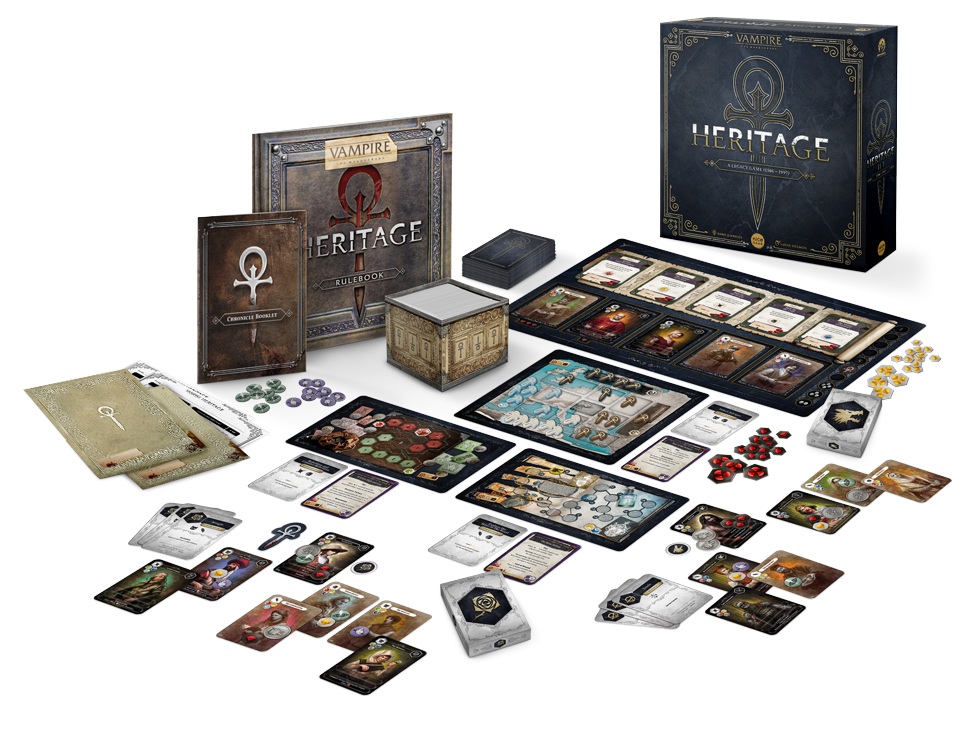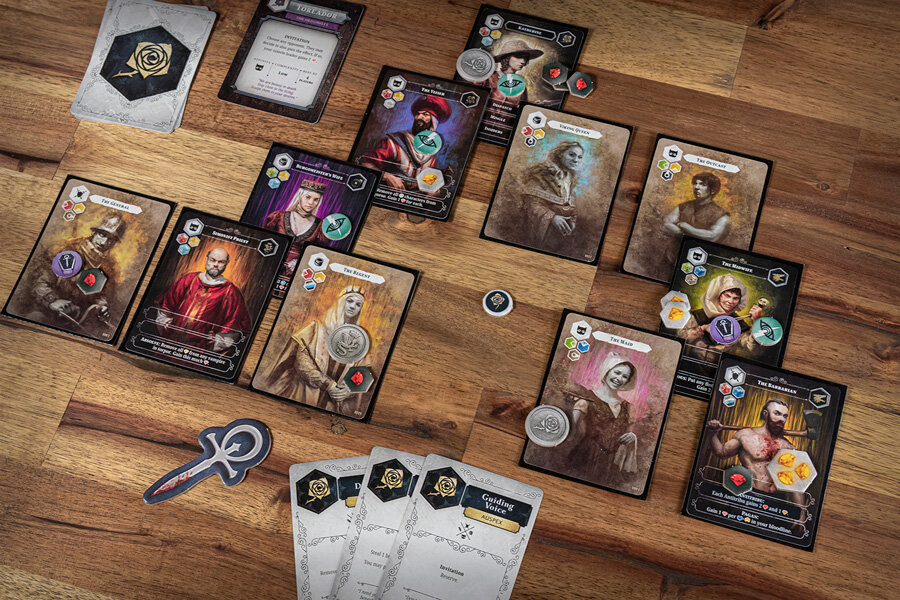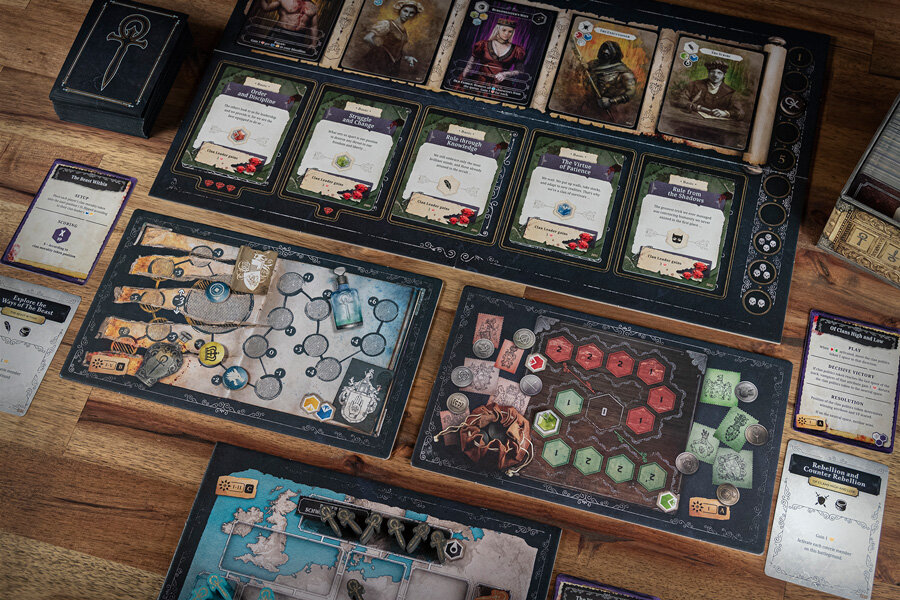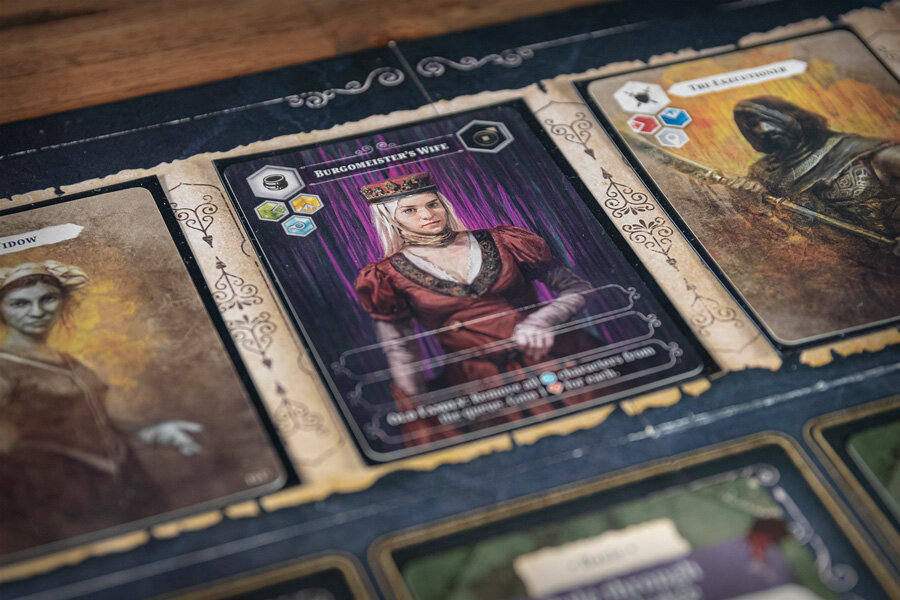Vampire: The Masquerade - Heritage – First Impressions
Review copy provided by the publisher
From Nice Game Publishing, Vampire: The Masquerade – Heritage is a legacy board game where vampire history is laid bare in the bloody fashion as the intra-clan politics behind the Masquerade become tangled and vicious. Sires birth new childer. Clans become more powerful. And seven hundred years of vampiric and human history intertwine as the original members of the Camarilla take the center stage.
In this game, players will assume the role of ancient vampires who lead their clans through vampiric strife, outside intervention, and societal change as entire eras of human history pass.
Heritage is designed as a fast-playing legacy game, with every step in the game creating new permutations and changes in character to the vampires that pop up throughout the timeline. Players fight over battlegrounds, literal and figurative, all in an effort to influence the course of history and maintain the Masquerade—as well as the shadowy power and control that vampires are able to exert when they operate outside of human awareness.
Building the bloodline is of utmost importance as players try to fulfill missions in each era while also strengthening the position of the clans. Each clan functions in a unique way, and it’s up to the players to leverage those abilities in their endeavors to affect history and emerge as the most powerful clan in the Camarilla.
Each game rewards players with more characters, abilities, and assets.
There is also a regular mode of play that players can explore, but the designers and Nice Game Publishing intended this as a legacy game with a larger historical lens through which players can view the vampiric clans and their global influence.
Teeth are bared. Blood is spilled. And players are hungry for some vampire history. Let’s look at what’s happening with Vampire: The Masquerade - Heritage.
What It Does
This is a card-drafting legacy game where players acquire characters from the board and recruit them into their Bloodline. Some of them are ordinary while others have become Ancilla with their own special abilities.
Enlarging your Bloodline gives you access to more characters who can help you activate Schemes, which are specific to the different Battlegrounds out on the table, or the Clan Schemes, which are unique to each of the nine Camarilla clans—Brujah, Gangrel, Lasombra, Malkavian, Nosferatu, Toreador, Tremere, Tzimisce, and Ventrue.
Use your clan’s special Schemes and the abilities of any vampires in your Bloodline to exert control in the historical period and complete the missions that influence events during that time period and the stature of your clan.
Battlegrounds are also important, as they represent territorial struggles across Europe, internalized battles within each vampire, and other conflicts important to the survival and growth of the Camarilla behind the ever-fragile veil of the Masquerade.
The legacy part of the game unlocks more characters, Schemes, and battlegrounds for players to explore. Ordinary characters can become ancilla vampires. Ancilla can develop more powers to exploit in future games. The focus of the vampire clans can shift in terms of what they fight for in future historical periods. And then the clans themselves will grow in different areas, which can be judged at the end of the legacy campaign for their value in the endgame scoring.
While the game starts pretty barebones, the introduction of new blood and opportunities for the clans as players progress through more games becomes pivotal for people to appreciate what Heritage is trying to accomplish.
How It Does It
The bloodline is what matters! Start with your Clan leader and then build a family of sires and childer that will help you win Battlegrounds and complete historical missions.
Each sire can have up to three childer. These characters are the elder member in the Bloodline with up to three younger members brought in underneath.
The board includes the characters that you can recruit into your Bloodline, the missions that you need to fulfill by the end of the narrative, and the three Battlegrounds that players will compete for.
This is the full visual puzzle that players will need to solve outside of their personal Bloodlines.
Characters can be ordinary and provide certain symbols for Scheme and Battleground activations…
Or they can be Ancilla with their own abilities that activate once recruited. Ancilla vampires with multiple abilities can make Heritage very exciting for players.
The clans of the Camarilla are all unique in the way that they play.
Slowing increasing their number of Schemes throughout the legacy game will give players more powerful and diverse options.
Why You Might Like It
Heritage uses the narrative infrastructure of the World of Darkness and Vampire: The Masquerade to create a character-focused game where the vampires become the biggest part of the story. If you like character-building in RPGs, the mechanics of this game actively allow you to do that.
This is a legacy game where the contents of the box can still be used for custom games after the campaign is finished.
Why You Might Not
Heritage takes a while to get started. If you play the custom game first or only get a few games into the campaign, it may be hard to see the potential.
The intense connection to the Vampire: The Masquerade source material can sometimes make it harder for players to learn the game as vocabulary and mechanical terminology leans into the vampiric world-building rather than the easiest way to teach the game.
Final Thoughts
This is a hard one for me because there is a lot of potential in Vampire: The Masquerade - Heritage but I also anticipate that many players may never unlock that same potential because of the time that it takes to reach it.
In today’s gaming world, it’s all too easy to play a game 1-3 times before moving on to the next shiny thing on your shelf of opportunity or pile of unplayed games. It takes commitment and intention for players to keep a game on the table for longer than that. Especially someone in my position who plays and writes as a reviewer or content creator.
And I mention this because the non-legacy game of Heritage would not be appealing for many players unless it involved the unlocked content from the legacy game. That’s the best part of this game. The characters you unlock, the extra Schemes that become available, the other battlegrounds that you learn how to use, and the combination of all those elements when you mix them together.
If you don’t have any of that and you’re starting fresh from opening the box, the custom game that you can play outside of the legacy campaign is overly complex and not engaging enough. It’s the skeleton of Heritage without any meat on the bones.
And then the legacy gameplay doesn’t really kick off until the end of the first era and into the second. That’s when players start to use Schemes that they’ve unlocked in previous games. It’s when Ancilla vampires with special abilities start to filter into the character deck and can be claimed for someone’s Bloodline. And also the Battlegrounds start to change out and give you other things to fight over during the campaign. This is particularly important since one of the first Battlegrounds is near-pointless after the first couple rounds of the game and doesn’t hold much of the players’ interest.
So… once you get to that point in Heritage, the game really starts to open up. You get a sense of the possibilities with the Ancilla vampires and the burgeoning strength of the Camarilla clans and the different historical and personal Battlegrounds all clashing together and creating a wild mix of vampire chaos. Players are really able to interfere with each other and create interesting combinations of abilities that wouldn’t be possible until enough content is unlocked or added into the decks.
Time is needed. Multiple plays are necessary. For some players, that loading bar at the beginning of the game before the real story unfolds will be frustrating and may prevent them from playing. If you can stick with it, there really is some fun gameplay ahead of you, but the slow start is a sticking point for sure.
Babis Giannios has created something interesting here and Nice Game Publishing has helped put out a sharp-looking game (the production quality is quite nice and will impress people wanting to get lost in the World of Darkness), but just be aware that you have to be patient before the real game gets underway.
It’s hard for me to recommend it as I imagine many players will not want the upfront cost in time and commitment to reach the full potential of Heritage, but I do see the value in what’s there as the legacy game fully expands into some real neck-biting vampire conflict. (Also, history buffs will appreciate the 700-year stretch that’s present in the game, but that’s a minor note.)
Either way, maybe this will help you be more informed about what to expect!
If you want to check out Vampire: The Masquerade - Heritage, you can visit the game's website or read what the community thinks on BoardGameGeek.
Are you familiar with the Vampire: The Masquerade universe? The World of Darkness? If mechanical growth and legacy gameplay interest you, then Heritage might be worth checking out.
Let us know in the comments and give a recommendation for other games of which to share our first impressions.
